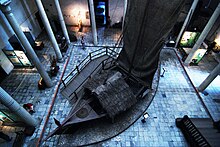
The mtepe is a boat associated with the Swahili people (the word "boat" in the Bantu Swahili language being mtepe). The mtepe's planks are held together by wooden pegs and coir, so it is a sewn boat designed to be flexible in contrast to the rigid vessels of western technique.
Extinction

The cessation of the production of mtepe has been ascribed to the arrival of the Portuguese in the Indian Ocean in the 15th century, leading to boat builders adopting alternative, western shipbuilding techniques.
Preservation
Nearly a dozen photographs and nine known model mtepe have been preserved. Three models are kept at the Fort Jesus Museum, a Portuguese fort built in 1591 located on Mombasa Island, Kenya. One model is kept at the Lamu Museum, 150 mi (240 km) north. One model is kept at the National Maritime Museum, Greenwich, London. One model is kept at the Science Museum, Kensington, London.
See also
External links
- Indigenous Boats: The Mtepes of Kenya, with images
Further reading
- James Hornell, 1941. "The Sea-Going Mtepe and Dau of the Lamu Archipelago" In: ''Mariner's Mirror'', January 1941.
- A.H.J. Prins, 1959."Uncertainties in Coastal Cultural History: The Ngalawa and the Mtepe.” In: Tanganyika Notes and Records No.55: pp.204-214.
- A.H.J. Prins, 1982. “The Mtepe of Lamu, Mombasa and the Zanzibar Sea.” Pp. 85-100. In: From Zinj to Zanzibar: Studies in History, Trade and Society on the Eastern Coast of Africa.(In Honour of James Kirkman). Eds. J. de V. Allen and Thomas H. Wilson. Paideuma: Mitteilungen zur Kulturkunde Vol.28. Wiesbaden: Franz Steiner Verlag.
- A.H.J. Prins, 1986. "Second Case Study: the Mtepe of the Swahili Coast." Pp.64-92. In: Ibid. ,Handbook of Sewn Boats: The Ethnography and Archaeology of Archaic Plank-Built Craft. Maritime Monographs and Reports No.59. Greenwich, London: The National Maritime Museum.
- Arabia to China — the Oriental Traditions, Jeremy Green, in The Earliest Ships: The Evolution of Boats Into Ships (Conway's History of the Ship), Naval Institute Press, 1996.
References
Citations
- ^ "The Mtepes of Kenya". 2012. Retrieved 8 January 2015.
- A.H.J. Prins. "Uncertainties in Coastal Cultural History: The Ngalawa and the Mtepe” Tanganyika Notes and Records No.55: pp.204-214
- ^ Robert Marshall Adams B.A.S. Construction and Qualitative Analysis of a Sewn Boat of the Western Indian Ocean. University of Minnesota, 1985.
- Harvey, Derek, Multihulls for Cruising and Racing, Adlard Coles, London 1990 p. 16, ISBN 0-7136-6414-2
Notes
- ie. coconut fibers
- They are in this manner similar to traditional lashed Polynesian craft, whose flexible construction techniques have in part been carried forward to modern cruising designs and championed by James Wharram.
| Types of sailing vessels and rigs | |||||||||||||||||
|---|---|---|---|---|---|---|---|---|---|---|---|---|---|---|---|---|---|
| Overviews | |||||||||||||||||
| Sailing rigs | |||||||||||||||||
| By sailing rigs | |||||||||||||||||
| Multihull vessels | |||||||||||||||||
| Naval and merchant sailing ships and other vessels (by origin date) |
| ||||||||||||||||
| Fishing vessels | |||||||||||||||||
| Recreational vessels | |||||||||||||||||
| Special terms | |||||||||||||||||
| Other types | |||||||||||||||||
| Related | |||||||||||||||||
This Africa-related article is a stub. You can help Misplaced Pages by expanding it. |
This sailing-related article is a stub. You can help Misplaced Pages by expanding it. |